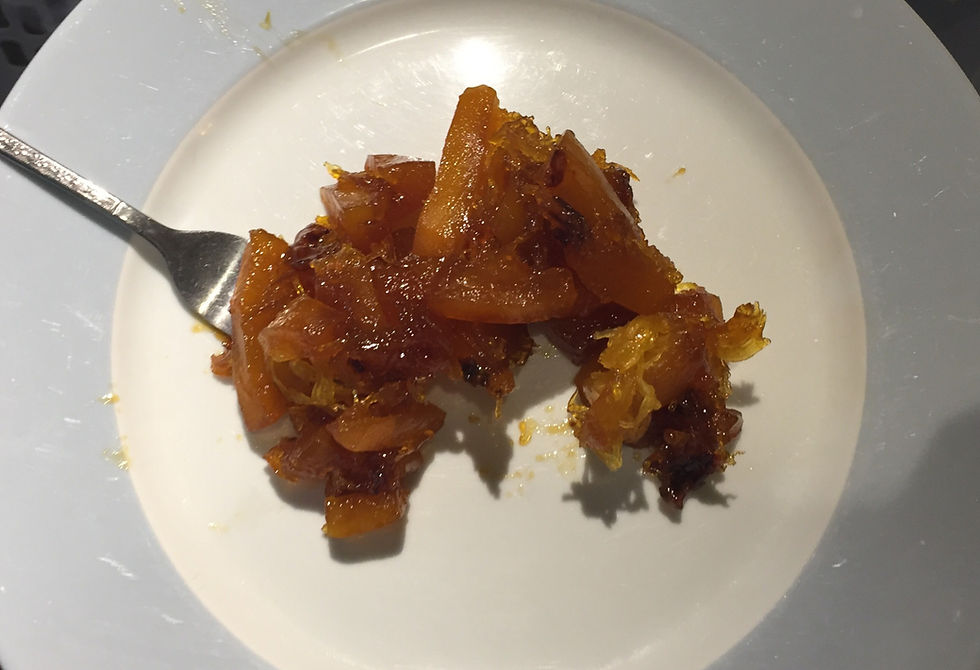Testing an 18th Century Candied Pumpkin Recipe
- Accokeek Foundation

- Dec 15, 2020
- 3 min read
Updated: Jan 5, 2021
We’re well into the winter holiday season, but that doesn’t mean we can’t still enjoy pumpkin, right? In today's calendar of seasonal flavors, we tend to restrict pumpkin to the fall, AKA: Pumpkin Spice Season, but historically pumpkin’s thick rind made it ideal for longer-term storage that meant it could be eaten into the winter.
A few weeks ago, I set out to find some unique pumpkin recipes from the 18th century, when I found this recipe, entitled "To make Pompion Chips” in a manuscript cookbook from Harriott Pinckney Horry:
"Shave your Pompion thin with a plain and cut it in slips about the width of your finger, put shreds of Lemon peal among it, wet your sugar with orange Juice and boil it into Syrup. Then put in your chips and lemon Peal and let them boil till done."
"Pompion" didn't give me much pause, as the term was interchangeable with "pumpkin" in many parts of the colonies, but a few other unusual things jumped out to me right away. To start, even knowing Mrs. Horry was from a prominent and affluent plantation family, (her mother, Eliza Lucas Pinckney, is credited with helping establish indigo as a South Carolina staple, while her brother, Charles Cotesworth Pinckney was a signer of the U.S. Constitution) the ingredients stuck out to me as being somewhat pricey and hard to come by - orange juice AND sugar AND lemon peel? Beyond that, the recipe feels so modern. Despite being a fairly sweet dish, the recipe doesn't call for any cream, wine, or even nutmeg, all staples of Anglo-American sweet dishes of the time. And beyond this still, the similarities between this recipe and modern Mexican candied pumpkin were striking.
What is Candied Pumpkin?
Known in Mexico as calabaza en tacha, candied pumpkin is typically associated with the day of the dead festival, and generally involves chunks of pumpkin boiled in a syrup, the remainder of which can be reduced and used to sauce the finished pumpkin pieces. This dish has indigenous origins, as pumpkin has been cultivated in Mesoamerica for hundreds of years, but nowadays it is often made with piloncillo, a form of raw cane sugar. Like all Mexican foods, traditional preparations can vary widely across different regions, but it can often be flavored with ingredients such as cinnamon, clove, and nutmeg. For a modern Mexican take on this dish, check out this post from Cocina California.
Like all 18th century recipes, this recipe doesn't do a lot of hand-holding. I used my best judgment and decided that "slips about the width of your finger" meant I should shoot for pieces of pumpkin that were about the size of long home fries, and my "wet" sugar ended up being maybe twice as much liquid as sugar

For my attempt, I used fresh pumpkin, turbinado sugar, and generic brand OJ, because that's what I had around my house already! (Unfortunately, my lemon mysteriously disappeared before I could use it.) Make sure if you make this you use a pumpkin labeled "baking pumpkin" or "pie pumpkin", as jack-o-lantern pumpkins don't tend to have as much flavor or an ideal texture.
I let my sugar mixture simmer until it was very slightly syrupy before adding my pumpkin pieces, but I would caution against letting it go too long, or the sauce will reduce too much to really simmer the pumpkin in.

My pumpkin took about 20 minutes or so simmering before it was done, but the cook time will vary depending on how big your pieces are and if you've refrigerated them beforehand. I let the finished pieces cool a bit before serving. The finished pumpkin had a sweet, slightly tart taste, with a sticky texture.

If you decide to make this, let us know! We can't know for sure what this dish was intended to be like, so there are many possible interpretations and variations. And if you want to try some other recipes from Harriott Pinkney Horry, you can purchase the published version of her manuscript cook book here. As always, Feel free to experiment and happy cooking!






